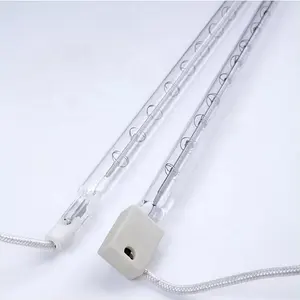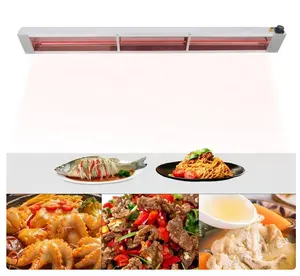
All categories
Featured selections
Trade Assurance
Buyer Central
Help Center
Get the app
Become a supplier

(1899 products available)




















































A heat lamp for paint drying is used to dry paint quickly by applying heat to the painted surface. These lamps are available in different types, which are as follows:
Infrared Heat Lamps:
These lamps emit infrared radiation through the heat without raising the temperature of the air around it. The heat is directly applied to the object, which makes these lamps more efficient. They are divided into two types:
Near-infrared Heat Lamps: These lamps emit short waves of infrared radiation. They are mostly used for quick drying of paint because they provide high levels of heat.
Far-infrared Heat Lamps: These lamps produce long waves of infrared radiation. They are used for drying paint that needs to be cured at a higher temperature.
Halogen Heat Lamps:
These lamps produce heat by passing electricity through a halogen gas. They are very efficient and provide immediate heat as the lamp turns on. They are also durable and provide a concentrated beam of heat.
Metal Element Heat Lamps:
These lamps produce heat through a metal heating element. They take time to produce heat, but the heat is consistent. They are also durable and provide a good amount of heat.
Standard Heat Lamps:
These lamps are mostly used for food warming. They are not suitable for drying paint because they can't provide the required amount of heat.
Compact Fluorescent and LED Lamps:
These lamps are energy efficient and provide low heat levels. They are mostly used in small spaces where less heat is required for paint drying.
Infrared Light
Infrared light is the primary feature of heat lamps. This light is usually divided into three categories: infrared A, B, and C. The lamps emit A and C infrared lights used for paint drying. Infrared A light is absorbed directly by the skin, causing a warming effect. On the other hand, infrared C is a shortwave light that heats the object without heating the air in between.
High-Temperature Bulbs
Heat lamps come with high-temperature bulbs usually measured in watts. The bulbs can range from 300 to 1000 watts or even higher. The right bulb needs to be chosen based on the size of the area being heated and the drying needs.
Adjustable Arms and Positions
Most heat lamps have adjustable arms and positions. This feature allows users to direct heat to specific areas of the painted surface. It is also essential for targeting hard-to-reach spots.
Sturdy Stand/Tripod
Sturdy stands or tripods provide support to the heat lamps. They are safe to use and position the lamps at the right height and distance from the painted surface. This ensures even heat distribution.
Timer and Thermostat
Some heat lamps come with built-in timers and thermostats. The thermostat feature allows users to control and monitor the temperature. While the timer allows users to set the duration of the drying process. This ensures optimal results and prevents overheating.
Safety Features
Safety features include; overheating protection, which prevents the lamp from getting too hot and causing damage or posing fire hazards. Other safety features include; stable bases, long power cords, and protective grids. These features ensure safe and efficient operation of the heat lamps.
Mobility and Portability
The best heat lamps are lightweight and portable. This feature allows users to move them from one place to another easily. They can also come with wheels for easy transportation and movement within a workspace.
Automotive Industry:
Heat lamps are used to dry paint on vehicles after they have been sprayed during bodyworks. They are usually mounted on tripods and directed to specific areas of the vehicle. This helps to cure the paint evenly and quickly. Also, using heat lamps instead of baking ovens reduces the costs and space required in the automotive industry.
DIYers And Professional Painters:
Heat lamps are an affordable and portable way to dry paint. They are easy to set up and use. They help to reduce the time taken to finish painting projects, increasing efficiency. They also reduce the need for a large space, making them suitable for DIYers.
Woodworking Shops:
Heat lamps are used to dry paint or finish on wood surfaces, including furniture. This is because they are safe to use on wood and help to prevent damage or warping. Using heat lamps minimizes the time required to complete a project, increasing productivity.
Art Studios:
Artists use heat lamps to dry paint on canvas quickly. This helps to prevent smudging or damage to the artwork. Heat lamps are also used to accelerate the drying process of oil paints that take a long time to dry. Additionally, heat lamps are used to cure varnish finishes on artworks.
Textile Industry:
Heat lamps are used to dry paint on fabric quickly. For instance, in the case of custom-printed t-shirts. This helps to prevent smudging or damage to the fabric. Additionally, heat lamps are used to set the dye on fabrics.
Construction Sites:
Heat lamps are used to dry paint on walls and other surfaces during construction. This is particularly in cold or humid conditions where paint takes a long time to dry. This helps to ensure that the paint is cured properly and the project is completed on time.
Industrial Coating Facilities:
Heat lamps are used to cure epoxy and polyurethane coatings on metal and other surfaces. This is because lamps provide a consistent and even heat distribution required for the curing process. Additionally, using heat lamps is more energy-efficient than using large ovens.
Safety:
When choosing a heat lamp, safety should be the top priority. Look for a heat lamp with a shatterproof cover to prevent glass from breaking and causing injuries. The heat lamp should also have a safety guard to protect the bulb from breaking. A heat lamp with a built-in thermostat will prevent overheating and possible fire hazards. The heat lamp should also have a long, durable power cord.
Portability:
A portable heat lamp for paint drying is preferred. A portable heat lamp is easy to move from one place to another. It will have a lightweight design and sometimes come with wheels. A portable heat lamp is suitable for projects done in different locations. It will have a small size, making it easy to store when not in use.
Mobility:
A good heat lamp for paint drying will have adjustable height and angle. This feature allows users to position the heat lamp where they want it. Some heat lamps have a flexible arm that can be adjusted at different angles. A heat lamp with a tripod stand is stable and will not fall over easily. The heat lamp should be easy to move around and stay in position until it is adjusted.
Ease of Use:
The heat lamp should be easy to operate. It should have simple controls that are easy to use. A heat lamp with a built-in timer will turn off automatically when the drying time is over. A heat lamp with a bright light is easy to see when it is on. The instructions on how to use the heat lamp should be clear and easy to understand.
Bulb Type:
There are different types of bulbs in heat lamps. The halogen bulb heats up quickly and provides a lot of heat. It is good for drying paint in a short time. The infrared bulb heats up slowly but distributes heat evenly. It is good for large paint jobs that require even heat distribution. A good bulb type will depend on the type of project being done.
Q1: Why use a heat lamp for paint drying instead of air drying?
A1: Using a heat lamp speeds up the drying process significantly, allowing for quicker project turnaround times. This is particularly beneficial in professional settings where time is of the essence. Additionally, controlled heat can help achieve a more even dry compared to air drying.
Q2: Are there any safety concerns when using heat lamps?
A2: Yes, there are potential safety concerns. It's crucial to monitor the distance between the lamp and the painted surface to prevent overheating or burns. Always follow the manufacturer's guidelines and recommendations to ensure safe usage.
Q3: Can any heat lamp be used for paint drying?
A3: Not all heat lamps are suitable for paint drying. It's essential to choose a lamp specifically designed for this purpose to ensure safe and effective results. Suitable options include quartz heat lamps and ceramic heat lamps.
Q4: What type of paint dries well with a heat lamp?
A4: Most oil-based and water-based paints are compatible with heat lamps for drying purposes. However, always check the manufacturer's recommendations to ensure compatibility and safe usage.
Q5: What is the ideal distance between the heat lamp and the painted surface?
A5: The ideal distance can vary depending on the type of heat lamp and the desired temperature. Generally, a distance of 12 to 18 inches is recommended. However, always refer to the manufacturer's guidelines to determine the appropriate distance for optimal results.